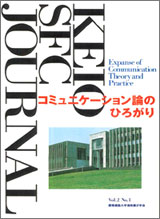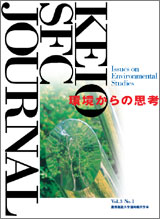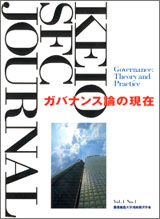- HOME
- KEIO SFC JOURNAL
- Vol.2 No.1

KEIO SFC JOURNAL Vol.2 No.1 Expanse of Communication Theory and Practice
published on 2003.03
-
Communication and Interaction
Michiaki Yasumura Professor, Faculty of Environmental Information, Keio University From the beginning, communication is an action or process conducted by human to human. Recently these relations have been broadened not only to machines but also to media. In such situations, communication should be discussed from the view point of human interface or human-computer interactions. This article first describes the three models of communication, then argues what is "understanding" in communication. Next, it focuses on the characteristics of communication, such as situation dependency, attractor, multi-modality and non-verbalization. As for the relationship between media and communication, several topics are introduced, such as the features of media, smiley marks, remote communications, and ambient communications. Finally the role of communications for disabled persons are outlined.
Download this article (PDF):SFCJ2-01.pdf -
From a Theory of Sense-Making to Socio-Semantics Further exploration into human communication dynamics
Masahiro Fukaya Professor, Faculty of Policy Management, Keio University Prof. Tanaka and I have engaged in a study of human communication dynamics for the last ten years. On the process of our collaborative work, we've proposed a theory of sense-making --- a new paradigm of human communication. This is theoretical model has now applied to the development of socio-semantics of which the goal is to reveal and identify the folk meanings of social concepts (phenomena). In our socio-semantics, the target of analysis is text. Texts relating to a social concept are to be analyzed with the use of a computer. Some case studies have been already carried out, producing insightful results.
-
Interpersonal Communication in Nursing Theories
Naomi Sugimoto Associate Professor, Faculty of Nursing and Medical Care, Keio University Communication has quickly become a popular subject in the field of nursing. The majority of nursing literature touches upon some aspect of communication. Many of those passing remarks on interpersonal communication in the literature, however, are based on frameworks developed in fields such as psychology or sociology, and hence often differ from perspectives held in the communication discipline. Given that, this article aims to examine how communication is characterized within the nursing literature. More specifically, the paper first surveys and analyzes implicit models of communication depicted in nursing theories. It then discusses implications of the various models vis-a-vis current theoretical frameworks used in the field of interpersonal communication.
-
A New Cognitive Model for Oral Reading Processes: Results of Studying Eye Movement Characteristics of a Phonological Dyslexic Patient
Misa Grace Kwok Doctoral Program, Graduate School of Media and Governance, Keio University Shun Ishizaki Professor, Faculty of Environmental Information, Keio University Tadahiko Fukuda Professor, Faculty of Environmental Information, Keio University The purpose of this study is to examine eye movement characteristics during reading and to build an oral reading-processing model, the basis of communication by written materials. A phonological dyslexic patient and unimpaired 'control' subjects were selected to experiment on oral reading with controlled words. Experimental analysis shows that the unimpaired subjects read each word as a "chunk" using their peripheral vision, whereas the phonological dyslexic subject read those words which he felt difficult to read, such as in a "letter-by-letter-reading" manner using only central vision. This is suggests the existence of a seperate language reading process in addition to regular dual-route and triangle models.
Download this article (PDF):SFCJ2-04.pdf -
Japanese as a Programming Language
Ken Okada Master's Program, Graduate School of Media and Governance, Keio University Yoshihide Chubachi Research Fellow, Keio Research Institute at SFC Hiroshi Suzuki Associate Professor, Tokyo Metropolitan College of Aeronautical Engineering Hajime Ohiwa Professor, Faculty of Environmental Information, Keio University Using Japanese as a programming language is discussed from the viewpoint of word order and efficiency of processing. By using Japanese, programming may be taught without taking into account of the grammar of the language and the learner can concentrate on composing their idea to be realized. The assembler of Java virtual machine is compatible with the Japanese language and a programming language named "Kotodama" has been developed. It supports both assembler level description and higher-level description of the programs and expected to be useful not only for the beginners but also for the experienced programmers as well.
-
Geometrical Property of Depth Perception and Depth Recovery in Stereoscopic Vision
Toshio Watanabe Professor, Faculty of Environmental Information, Keio University Keiji Nishioka Professor, Faculty of Environmental Information, Keio University How accurately can we reproduce real depth in stereoscopic vision? In the present study, subjects judged the distances and the angles of certain objects presented in both the horizontal plane 3 m in depth in the stereoscopic condition and in a direct observation condition. As a result, it was found that the distances in stereoscopic vision were almost the same as those in the direct observation, but that the angles were different. Furthermore, it was found that stereoscopic space had an anisotropic property, as does visual space.
-
Comparative Analysis Concerning Owner-Occupied Housing Investment in Japan and the United States
Kenichi Shiraishi Part-time Lecturer, Faculty of Policy Management, Keio University The purpose of this paper is to analyze empirically determinants of household owner-occupied housing investment in Japan and the United States. There is original feature to analyze household owner-occupied housing investment by unifying sort of data , measure of variables , estimation periods , type of demand function between Japan and the United States. As a result of this analysis , the following point is clear . The share of imputed rents is higher in Japan than in the United States except some years . This fact is caused by the factor that income elasticity of imputed rents is higher and the absolute value of price elasticity of imputed rents is lower in Japan than in the United States because of the difference of preference between Japan and the United States.
Download this article (PDF):SFCJ2-07.pdf -
A New Suspension System for Electric Vehicles − Invention, research and development of an 8 wheel tandem-wheel suspension system
Masahiro Onishi Doctoral Program, Graduate School of Media and Governance, Keio University Kiyomoto Kawakami Researcher, Japan Science and Technology Cooperation Yuko Kakizaki Researcher, Japan Science and Technology Cooperation Shiro Matsugaura Doctoral Program, Graduate School of Media and Governance, Keio University Hiroshi Shimizu Professor, Faculty of Environmental Information, Keio University This is study will outline the invention and development of a new suspension system for an electric vehicle named the Tandem Wheel Suspension System (TWS). TWS is a new suspension concept that makes a great progress in space utility, ride comfort and maneuverability. A major aspect of TWS is the replacement of the 4 large wheels with 8 smaller wheels. The four pairs of adjoining wheels are connected with hydraulic piping and hydro-pneumatic spring shock absorber units. The results of simulations reveal that the ride comfort of TWS should demonstrate an improvement of 3.6 times. Maneuverability of the TWS has been verified by skid pad tests using the high performance electric vehicle "KAZ", which has proven its excellent handling
-
A New 'Bottleneck' Factor Debilitating Chinese Economic Development − Current problems and perspectives concerning the commercial distribution system in China
Toshiyuki Kagawa Professor, Faculty of Policy Management, Keio University Sun QianJin Research Fellow, Keio Research Institute at SFC This is paper focuses on several points of current problems and perspectives concerning a commercial distribution system within the Chinese national economy. The present authors clearly focus on the sluggish commercial distribution system in China as one 'bottleneck' factor debilitating Chinese economic development despite the widespread implementation of market reforms and the open door policy.

